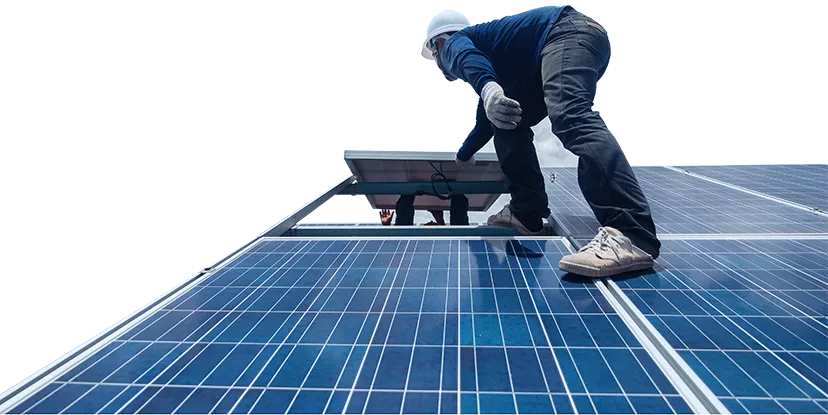The Sunshine Story: How Solar Panels Power Indian Homes
The Sunshine Story: How Solar Panels Power Indian Homes
The Sunshine Story: How Solar Panels Power Indian Homes
Ever wondered how those sleek panels on rooftops actually power homes? It’s surprisingly simple. Solar panels contain photovoltaic cells made of silicon layers with opposite charges. When sunlight hits these cells, it knocks electrons loose, creating an electric current. This DC (direct current) electricity flows to an inverter, which converts it to AC (alternating current) – the type your home appliances use.
Think of solar panels as tiny power plants on your roof, silently working whenever the sun shines. They even generate electricity on cloudy days, just at reduced capacity. Most residential systems connect to the power grid, allowing you to pull electricity when needed and send excess back for credits through net metering, a growing concept in India.
The beauty of solar is its simplicity – no moving parts means minimal maintenance. Just occasional cleaning to keep them free from dust and debris, a common concern in many parts of India. Once installed, they’ll keep generating clean electricity for 25-30 years with very little attention required.
Financial Benefits of Switching to Solar Energy in India
The numbers don’t lie – solar is a smart money move in India in 2025. With installation costs dropping significantly over the last decade, the average Indian homeowner can now see a quick return on their investment.
Here’s what makes solar such a financial winner for Indian households:
- Immediate Bill Reduction: Most homeowners see their electricity bills drop 50-100% from month one, a significant relief given rising power tariffs.
- Protection from Rate Hikes: While utility rates continue to climb, your solar costs remain fixed, providing long-term financial stability.
- Increased Property Value: Homes with solar typically sell for more than comparable properties, adding a valuable asset to your home.
- Government Subsidies and Incentives: The Indian government actively promotes solar adoption with various subsidies for residential rooftop solar installations and tax benefits, making it even more affordable. Many states also offer additional incentives.
- Faster Payback Period: With strong government support and falling costs, the payback period for a solar system in India is increasingly attractive.
The math is straightforward: invest once, save for decades. A typical system generates substantial electricity savings over its lifetime, offering a return that often beats traditional investments.
Environmental Impact: Reducing India’s Carbon Footprint
Going solar isn’t just good for your wallet – it’s a power move for the planet, especially vital in a rapidly developing nation like India. The average residential solar system offsets a considerable amount of carbon dioxide annually. That’s like taking a car off the road for an entire year!
Traditional electricity in India relies heavily on fossil fuels, which release harmful greenhouse gases when burned, contributing to air pollution in many cities. By switching to solar, you’re directly cutting demand for coal and natural gas. Your clean energy choice creates a ripple effect beyond just carbon reduction:
- Decreased Air Pollution: This leads to improved local air quality, a critical benefit for public health in India.
- Reduced Water Usage: Conventional power plants consume massive amounts of water, a precious resource in India. Solar helps conserve it.
- Less Land Disruption: Reduces the need for extensive mining and drilling operations.
- Lower Strain on the Electrical Grid: Especially during peak demand, solar helps stabilize the grid.
Want perspective? A single home going solar has roughly the same environmental impact as planting 100-150 trees each year. Now multiply that by your neighborhood, city, or state – the collective impact is enormous for India’s sustainable future.
The Latest Solar Technology Innovations (2025) for India
Solar tech is evolving at lightning speed, and 2025 has brought some game-changing innovations to the Indian market.
Bifacial panels are now becoming mainstream, capturing sunlight from both sides and boosting energy production by 15-25% compared to traditional panels. These panels work especially well in open spaces or on elevated structures, maximizing energy capture.
Integrated storage solutions have become more affordable too. The newest battery systems store excess daytime energy at nearly 95% efficiency, providing power through outages and peak evening hours when electricity rates are highest – a crucial feature for reliability in India.
For homes with limited roof space, high-efficiency panels now convert up to 25% of sunlight into electricity (up from 15-18% just five years ago). This means more power from fewer panels, ideal for urban settings.
Smart solar management systems have also evolved. AI-powered monitoring now predicts maintenance needs, optimizes panel performance based on weather forecasts, and automatically adjusts your home’s energy usage to maximize solar consumption. These intelligent systems are making solar ownership even more seamless.
Perhaps most exciting is the emergence of solar shingles 2.0 – virtually indistinguishable from regular roofing materials but capable of powering your entire home. They’re finally competitive on price with traditional panel installations while offering superior aesthetics, offering an elegant solution for modern Indian homes.
Have these advancements in solar technology made you think about harnessing the sun’s power for your home?


